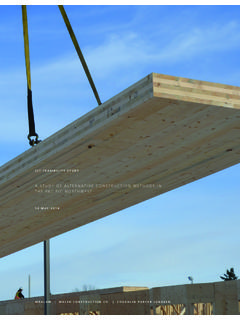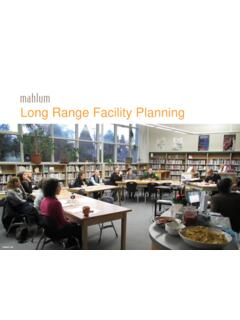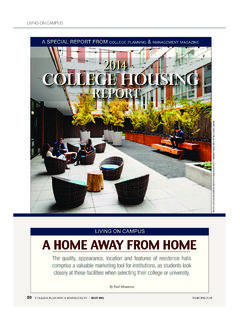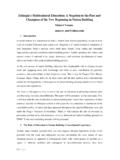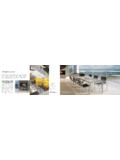Transcription of History of Healthcare Arch Burpee - Mahlum
1 Throughout western History , the place where the sick have been cared for has transformed. These healing environments have ranged from the home, to the church, and then developed to what we now understand as in History , the sick were cared for in their homes. Later, religious orders took responsibility for looking after the infi rm within their churches or cathedrals. The Catholic Church became the most powerful provider of health care, and monastic orders were the caretakers for the sick. Hospitals were often located on the edge of villages or cities, and populations often grew to surround the hospital. In Europe s more affl uent cities, hospitals became civic enterprises rather than religious centers. Although they were often run by religious orders, they maintained a distinct civic role within the community. Many of these buildings were structured around large central courtyards with smaller secondary courtyards delineated by the wards. Many of these hospitals resembled schools within the urban landscape, and this building form permeated the urban hospital landscape through the 19th the late 1700 s a re-evaluation of the hospital form was prompted by Louis XV in Paris, who developed a committee charged with creating standards for fundamental reform of the basic hospital typology.
2 This sea change was prompted in part by the new recognition of clean air and hygienic conditions as agents of health, especially within hospital environments. The reformers believed that health primarily c ame, not from medical solutions, but from creating a pure, natural environment that provided clean air. Two architectural proposals were made: a radial solution and a pavilion system. The pavilion system became a very infl uential form; the fi rst was H pital Lariboisiere, built between 1839 and 1854 in Paris by Nightingale (1820-1910) was a very infl uential fi gure in nursing following the Crimean war in 1854 and is lauded for her intuitive, observational approach. She recognized that cleanliness within the hospital ward correlated to patient survival, a quarter century before Louis Pasteur formally proposed his germ theory of disease. During the Crimean War of the 1850s, she was able to decrease the death rate of wounded soldiers remarkably from 60% to 2% within six months.
3 Nightingale is lauded as the mother of modern nursing, History of Healthcare Architectureby Heather BurpeeIntegrated Design Lab Puget Sound (2008)iPage 1 of 3and her humanist approach infl uenced hospital design far beyond her time (Straus, 2006).Nightingale s passion for creating a better healing environment for patients prompted her to write Notes on Hospitals in 1863 outlining her priorities for designing hospitals. Her approach to creating a healing environment for patients not only looked at the physical surroundings, but also looked at the social welfare of her patients. She focused on providing patients with access to natural light, air, landscape, attention to diet, as well as a cleanly, sanitary environment. She observed: Artifi cial ventilation may be necessary, [but] it never can compensate for the want of the open window .. Second only to fresh air, however, I should be inclined to rank light in importance for the sick .. Among the kindred effects of light I may mention, from experience, as quite perceptible in promoting recovery, the being able to see out of a window, instead of looking against a dead wall; the bright colors of fl owers; the being able to read in bed by the light of a window close to the bed-head.
4 It is generally said that the effect is upon the mind. Perhaps so; but it is no less so upon the body on that account. Florence Nightingale from Notes on Hospitals, 1863 Nightingale s principles were fi rst implemented in H. Currey s design of St. Thomas s Hospital in London, which was built between 1861 and 1865. The interior planning of this hospital refl ects the pavilion confi guration of the nursing unit with effi cient circulation, and humanistic principles that she outlined in her work. Nightingale s infl uence on hospital design was recognized and implemented over the next hundred years. Its far-reaching effects can be seen from the early works of the Veterans Administration hospitals in the United States until the beginning of World War general plan of these pavilion style hospitals included a primary supply corridor for circulation of people and supplies with fi nger plan patient wards that extend off of this linear spine. The thin pavilion plan allowed light and fresh air to penetrate and created garden views between the building crenellations.
5 This design emphasized function over form, even though the functional building was cloaked in the Victorian facade of the time (Verderber, 2000). The inclusion of environmental factors that contribute positively to healing in preference to any other design element represents the precursor to evidence based design, a contemporary movement and infl uence in hospital building today (Wagenaar, 2006).In the hospital boom following World War II, Florence Nightingale s original concept of hospitals with fresh air, light, and views was replaced by deep plan hospitals that prioritized effi ciency over human comfort and healing. The hospital form began to shift from a pavilion style to what is referred to as a podium on a platform typology. A typical hospital confi guration became a deep span, multi-fl oor block (or platform) with a patient tower placed on top (as a podium). building technology aided in this transformation with a new ability to create long span structures, mechanically ventilate interior spaces, and move people vertically with elevators.
6 It is estimated that, at the peak of this typology, nurses spent 40% of their time in patient transport logistics (Jones, 1995). Circulation patterns were confusing, without any external cues of directionality, setting or hierarchy. Ultimately, the attitude of the hospital as a well-tuned machine took precedent over more humanistic factors for the patients, staff, and visitors to these facilities. The approach of a mechanized place of Healthcare in these mega hospitals is epitomized by the description of one author about this typology:With the aid of air conditioning and deep span frame structures it becomes possible to plan a hospital like a department store, in one continuous fl oor, occupying the whole of the site. (James from Hospitals: Design and Development, 1986)Through time, with the progression of diagnostic and treatment facilities, this platform has gotten bigger and taller, limiting access to the aspects of natural air, light, and view that Nightingale attributed to her patients well-being.
7 Designers and builders maximized the machine-like effi ciency of hospitals without evaluating how these changes in form related to human health, stress, and comfort. In the United States we have maintained a similar hospital typology History of Healthcare Architectureby Heather BurpeeIntegrated Design Lab Puget Sound (2008)Page 2 of 3>Evolution of patient care from the home to Podium on a Platform typology. Development of building systems and medical technology aided in the transformation to a vertical arrangement between the diagnostic and treatment areas and the patient wards. This usually results in deep plan arrangements, limiting access to daylight and fresh air, and creates limitations in vertical transportation due to multiple patient transfers between treatment facilities and the wards. ( Burpee , 2008) since the fi rst major hospital building boom after World War II. We are still building hospitals with very deep fl oor plates and subterranean spaces with little or no relationship to the outside re-examination of this typical block hospital form has occurred in Northern Europe, beginning as early as the 1980s.
8 Changing the typical form of the hospital created more human scale facilities that allowed more access to daylight and outdoor space. Initially, a horizontal relationship between diagnostic and treatment facilities with patient wards was established. This opened the possibility to allow natural light, air, and view into these spaces and also decreased the restrictions that occur with vertical transportation of patients. Challenges that this confi guration incites are fl oor-to-fl oor height variations between the treatment building and the patient wings as well as increased elongation of the hospital form. The diffi culty of fl oor-to-fl oor height differences is resolved in many of these facilities by incorporating interstitial spaces. The horizontal typology then evolved into a layering approach, where the hospital was more integrated into the urban landscape. This idea of hospital placemaking is an urban design concept that frames the hospital as an enterprise that plays a greater role in its surrounding community.
9 These designs incorporate a layering approach where several buildings serve as clinical centers of excellence, clustering together to form the overall hospital. This decentralized approach combines the ideas of the block hospital and the horizontal typology with imaging, surgery, and bed fl oors located in each block of these centers of excellence forming small hospitals within the larger hospital facility. The fi nal approach that is taking hold in Northern Europe is ultimate fl exibility in programmatic distribution. This concept combines the urban placemaking typology and layering approach, and incorporates mechanical and structural design that allows any programmatic function to reside in any place within the building . This eliminates the problematic fl oor-to-fl oor height variations and organizational and programmatic changes that are inevitable over the life span of a hospital. Providing fl exibility over is accumulating that correlates indoor building environments with human health and productivity.
10 Evidence Based Design is a research fi eld that specifi cally looks at the role of the hospital building related to human health, healing, and comfort. This research is relatively new, emerging in the 1980 s, and derives its name from the medical fi eld s Evidence Based Medicine. While these Evidence Based Design studies are in their infancy and need more depth to be complete, they really derive their hypotheses from intuitive approaches to design and human comfort. In fact, Evidence Based Design relates to work as far back as the enlightenment when Nightingale and others observed a connection between the natural environment and healing. A connection to natural light, fresh air and view are cited History of Healthcare Architectureby Heather BurpeeIntegrated Design Lab Puget Sound (2008)Page 3 of 3in many research papers as being positive aspects to patient, staff, and visitor health healing, and productivity in the hospital , in a contemporary context, one cannot simply emulate Florence Nightingale s plan.
